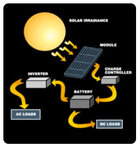binaryninja
Member level 3

I am a bit confused about stand-alone pv systems diagrams. Many of them show something similar to the attached pic. If the system is designed in this manner, how would the battery be able to charge and discharge at the same time? It can't just wait until the battery is depleted then start charging because that would disconnect the load. How is it possible to provide the load and keep the battery voltage up? If you have any knowledge or experience please help me!
THANKS!
THANKS!


